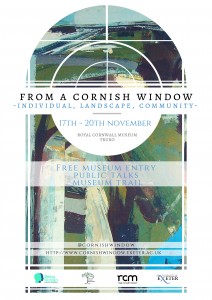A precious painting, a class of children, and writing or painting tasks might sound like a very bad idea, but not if you live in Cornwall. As part of the ‘From a Cornish Window’ mini-festival of Being Human 2014, small groups of undergraduate students and University staff organised workshopping sessions to promote the humanities and creative thinking in local primary and secondary schools.
The training and planning offered us a lot of freedom to take the themes and the central piece of art work which the Royal Cornish Museum would be bringing to the class room and come up with a creative way of making the children think differently about art. My group (Gemma, Aisha and myself) wanted to encourage unnatural, mismatched portraits and unearthly figures in the creative writing. So for our starter task we devised an exercise which encouraged the creation of unusual faces. We marched around the University to find faces in magazines; this was slightly more difficult than we first imagined but we succeeded none the less. Then we cut the faces into strips so we had different sets of eyes, noses, mouths, chins and foreheads. As you can imagine we were quite pleased with ourselves and couldn’t wait to see what the pupils made of it.
We arrived at the Primary school, yawning a little, at 8.45 and were swiftly directed to the first classroom we would be stationed at. Then we were told that the day starts with a brief aerobics session! We were invited to join and our supervisor Dr Andy McInnes started the day with an awful lot of star jumps. It was great to see the school doing something so active in the mornings and I think we should implement that idea at University! There would definitely be fewer droopy eyes of a morning, but I don’t think there is enough coffee in the world that could convince students to join in!
Initially I was slightly worried about the painting we would be showing Years 1, 2, 3 and 4. The Figure (1955) by Roger Hilton is not the easiest of paintings to explain. Follow this link to see for yourself: http://www.bbc.co.uk/arts/yourpaintings/paintings/figure-14566. I thought we might end up with a lot of blank faces but I was wrong!
After our starter resulted in some very bizarre and funny faces, Jane from the Royal Cornish Museum unpacked the carefully transported painting and showed it to the class. As soon as she asked them what they thought almost every hand flew into the air. The responses we got were amazing, ranging from the general agreement that it was “weird” to the stunning descriptions of “a half remembered figure” and one of my particular favourites “a pirate from Malta”. The children saw “wine glasses” and “chicken legs”, a “space man hat” and “a face on his t-shirt”. It was impressive to see their minds at work and their responses were definitely more creative than my original interpretation that it was a dog, sitting on a book on a chair… I think I’ll stick to writing about books; becoming an art critic is probably not a career path for me! By the time Year 3/4 started writing we realised it was a pretty talented group. The stories they came up with were so imaginative, funny and beautifully written. I cannot wait for them to be displayed so everyone can enjoy them and the children can show their parents.
When we started the next session, the painting workshop, we were again impressed with the skill and inventiveness, this time of 5-7 year olds. They took to the idea of mismatched faces at once and there was a lot of giggling as they decided their portraits would have arms coming out of the head where the ears should be or an ear for a nose or huge eyes. At the end of the session, the final pictures were stunning and the classroom even escaped relatively unscathed by our artists. Some really captured Roger Hilton’s style and others were finished with such care and detail you would never realise how young the painter was.
Overall we were treated to a fantastic day at Mawnan Primary School with some talented and creative kids who definitely thought about Cornwall and art in an interesting way and encouraged us to do the same. The final pieces of artwork and creative writing were fantastic and will be on display at the Royal Cornish Museum between the 17th and 22nd of November.
By Kathryn Clark




